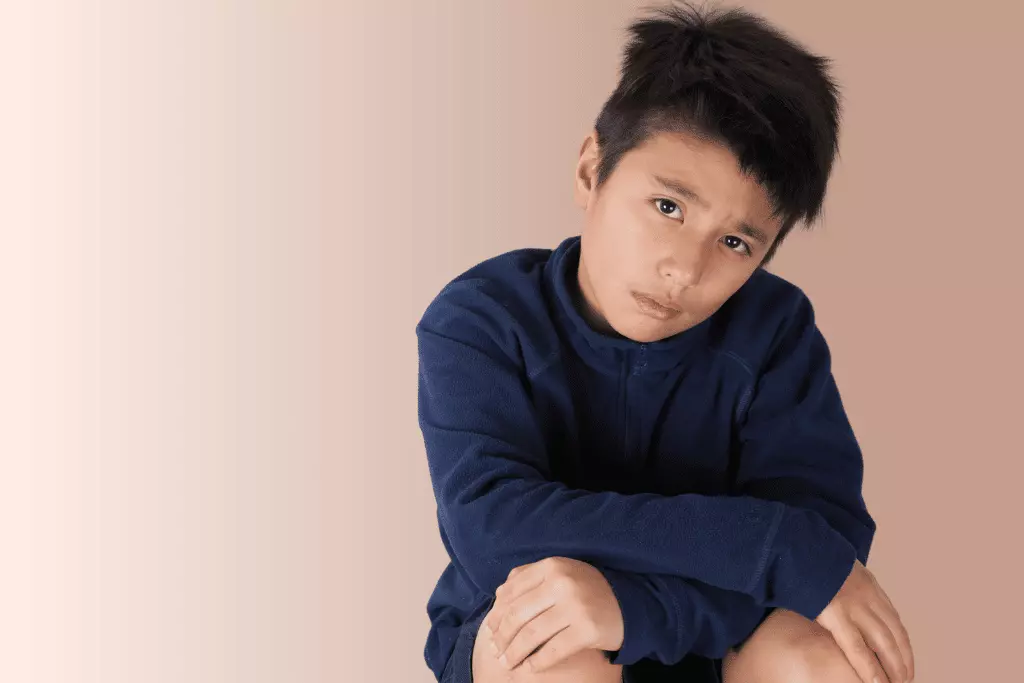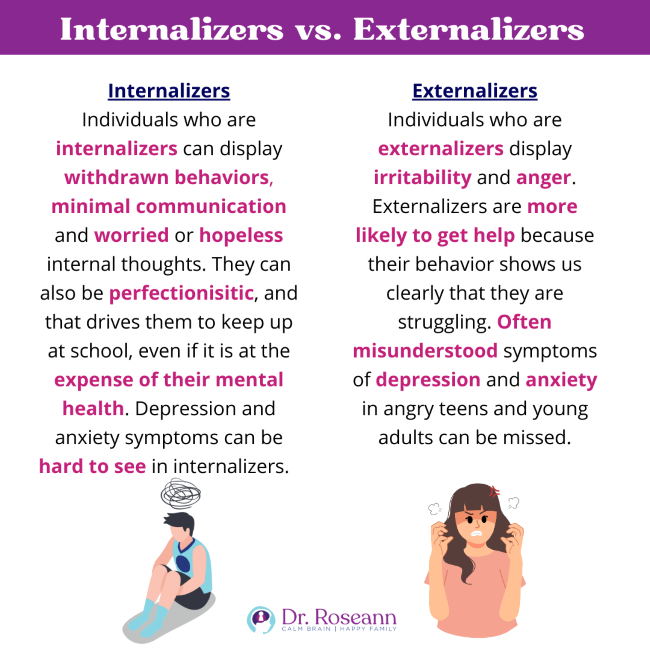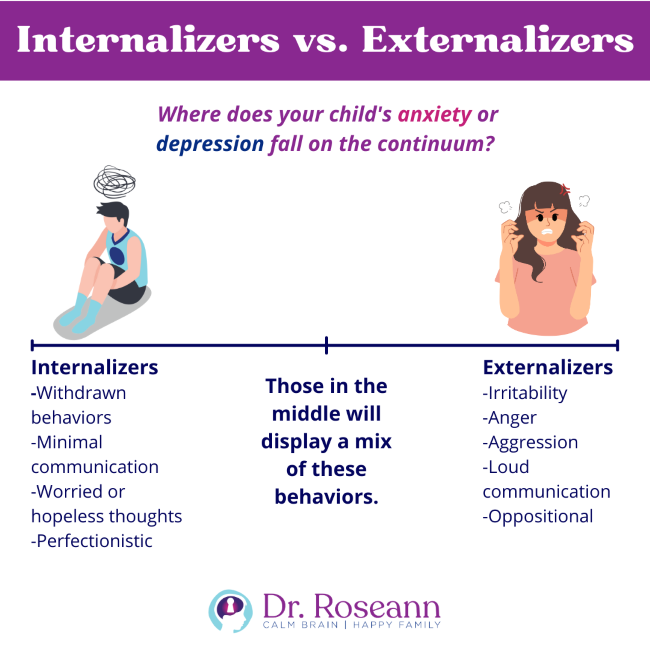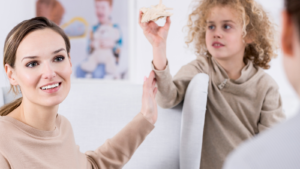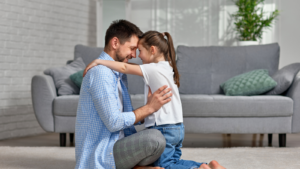Does your child show signs of stress, worry, lack of self-confidence, fear, or other symptoms of anxiety? Well, your child isn’t alone. Research indicates that 8.3 percent of teens aged 13-18 have an Anxiety Disorder classifying as severe impairment range with the average onset age listed six-years-old. In the U.S., Anxiety Disorders are the most common mental illness, affecting 40 million adults age 18 and older, or 18.1% of the population every year.
What are Signs of Anxiety in Children & Teens?
Anxiety disorder symptoms look different in children and teens than in adults, so it is important to know the signs and symptoms of anxiety in children. Children often display their anxiety or worry behaviorally. Behaviors appear along a continuum from internalizers who hold things in to externalizers who show their internal stress.
Some children may show sleep problems and stomach aches, while others may show frequent rage or tantrums. Teens may be cranky or avoid contact. Each young person’s way of dealing with anxiety is different. Anxiety symptoms can also mimic attentional or learning issues because children cannot concentrate if they are worrying all the time.
Emotional and Behavioral Signs of Anxiety
- Excessive worry
- Trouble going or staying asleep
- Frequent nightmares
- Fatigue
- Trouble concentrating
- Irritability
- Overly sensitive
- Cries easily and frequently
- Emotional lability (up and down emotionally)
- Anger or rage
- Long tantrums or meltdowns
- Lack of self-confidence
- Fearfulness
- Phobias
- Separation anxiety
- Constantly seeks approval
- Rituals, compulsions, obsessions
- Perfectionistic tendencies
- Rigidity
- Negative talk or a tendency to think the worst
- Sensory processing difficulties
- Social avoidance or difficulties
- Attention or focus problems
- Gets distracted by worried thoughts
- Fear of speaking in public or to strangers
- Low frustration tolerance
- Frequent erasing of work
- Won’t turn in school work
- Test anxiety
- Avoids new experiences
- Says, “No” all the time
- Worries about things in the future
- Hyperverbal looping of worries (e.g., says “Why did she do that” over and over)
Physical Signs of Anxiety
- Muscle tension
- Difficulty relaxing
- Physical pain
- Headaches
- Stomach aches
- Red face in social situations
- Hives or skin conditions (unexplained)
- Hair loss (unexplained)
- Excessive sweating
- Holding of bladder or bowels
- Frequent urination
- Hyperactive behavior
- Sleep problems
What Causes Anxiety in Children & Teens
Sources of childhood anxiety include but are not limited to genetic predispositions, situational stressors, environmental issues, and comorbid conditions such as Autism, ADHD, Sensory Processing Disorder, Learning Disability, and medical issues. Thus, a family history of anxiety can make, your child more likely to be diagnosed with anxiety whether from genetic inheritance or exposure to familial stress manage stress through how they manage stress, it is very important for parents to do they best they can to support their own stress and mental health.
Anxiety can also result from long-term chronic stress which disrupts both the nervous system and causes stress activated brain wave activity. The high levels of academic and social pressure on children and teens also contribute to anxiety.
Moreover, your child’s or teen’s disposition or outlook may increase susceptibility to stress increasing anxiety. In other words, a glass half empty kind of kid will be more prone to worry and negative thinking. No universal standard exists for how to alleviate anxiety but we have good natural and clinical therapies that work.
What is the Difference Between Anxiety & Stress?
Stress is a normal and natural responses to challenges or frustrations. Anxiety, however, interferes with our daily functioning because the anxious feelings or behavioral symptoms are disproportionate to the real or imagined worry or issue. Since anxiety lingers, children or teens (and adults!) often experience looping or spinning thoughts.
When Does Anxiety Become a Disorder?
Professionals classify persistent anxiety (typically 6 or more months) that interferes with one’s daily functioning (school performance, home life, social functioning, etc) as a disorder. Within that categorization, several disorders, varying by primary symptom, are classified as an Anxiety Disorder which means no single anxiety disorder tests exists. Often, symptoms of depression and anxiety look similar or persistent anxiety can lead to depression, which is why parents should seek professional support.
What is Generalized Anxiety Disorder (GAD)?
GAD, the most common Anxiety Disorder, is characterized by persistent and excessive worry about a number of different things. Worry seems out of proportion to the event, with individuals typically expecting the worst for no apparent reason.
Most people with anxiety worry about multiple things (school work, friends, experiences) and display physical signs of anxiety (muscle tension, sleep problems, stomach problems). Despite recognizing their worry doesn’t make sense, children and teens with GAD feel unable to control their worry.
What is Obsessive-Compulsive Disorder (OCD)?
An OCD diagnosis incorporates unreasonable thoughts and fears (obsessions) leading to compulsive behaviors. Individuals engage in compulsive behaviors attempting to end the obsessions, decrease distress, or stop bad things from happening.
Germ and contamination concerns, cleanliness fixations, religious over-observations (Scrupulosity), aggressive or sexual impulses, and symmetrical or organization obsessions are common. Common compulsions include checking, washing/cleaning, and arranging. If left untreated, OCD can be chronic and involve multiple obsessions and compulsions, ultimately interfering with schoolwork, family, or social activities. Typical OCD onset occurs between ages 8 and 12.
Despite OCD often being treatment resistant, early intervention is key to break the behavioral pattern. So, when you see obsessive compulsive behaviors in your child, don’t wait to seek help from a psychotherapist who specializes in OCD treatment.
What are Phobias?
What is a Panic Attack?
Experiencing a major life stressor (school issues, parent divorce, bullying, moving, etc) or having a comorbid condition (Depression, GAD, etc) makes them more likely to occur. Research notes that depression and anxiety are comorbid because feeling they lack control over their lives can lead to feelings as though they have no recourse, thus depression can result.
Additionally, females experience panic attacks twice as often as men. Children and teens who worry about having another episode may change behavior to avoid a panic attack, so look for avoidant behaviors. Getting treatment for panic attacks and anxiety is important so your child can gain coping skills.
What is Separation Anxiety Disorder?
Fear of separating from a parent, typical in children ages one to three, is a natural part of early childhood. However, Separation Anxiety Disorder occurs in older children whose emotional response when a family member or caregiver absence leads to uncontrollable distress and inability to regain control coupled with excessive anxiety away from home.
Children with separation anxiety worry that their parents will come to harm which may result in school refusal, activity resistance, or family bedtime rituals to maintain closeness. For those with separation issues at bedtime, obsessive compulsive behaviors often can accompany bedtime rituals. A common disorder affecting four percent of children, it is also a common feature of PANS/PANDAS.
What is Social Anxiety Disorder?
Social anxiety is more than just shyness. Social anxiety is the fear of being judged and evaluated negatively by other people creating feelings of inadequacy, inferiority, embarrassment, humiliation, and depression that lead to avoidance.
Generalized social anxiety makes people anxious, nervous, and uncomfortable in almost all social situations. Young children may throw tantrums or cry when on playdates or in social situations. Adolescents may avoid social interactions or speak very little when in groups or with unfamiliar people and lack the coping skills to manage the uncomfortable sensations they expirence.
What is Selective Mutism?
Selective Mutism is a more extreme version of Social Anxiety Disorder. A complex childhood anxiety disorder, children cannot speak or communicate effectively in select social settings, such as school or out in public but are able to speak and communicate in settings where they are comfortable, secure, and relaxed (such as at home). While it is more common in younger children, it can present itself in older children as well. Regulating the nervous system with tools such as neurofeedback coupled with play therapy is a very effective treatment for selective mutism.
What is Post Traumatic Stress Disorder (PTSD)?
Post-Traumatic Stress Disorder (PTSD) is a disorder typified by difficulty recovering after experiencing or witnessing a terrifying event. The traumatic event that causes PTSD can be big or small. Researchers now expand the definition of trauma beyond war, natural disaster experience, or abuse to include medical experiences, grief, and a variety of other experiences.
If not addressed, PTSD symptoms can last for weeks, years, or a lifetime. The disorder affects how the brain and body function. Symptoms may include nightmares or unwanted memories of the trauma, avoidance of situations that bring back memories of the trauma, heightened reactions, poor attention or cognitive functioning, behavioral issues, sensory processing problems, physical pain, anxiety, or depressed mood. Children and adults can experience PTSD.
While some individuals with PTSD experience extremely high levels of distress causing them to struggle with daily life and relationships, others learn to cope with high levels of anxiety. Since many things can subconsciously trigger anxiety, moving past the trauma becomes difficult.
How to Control Anxiety in Children & Teens
Even with increased child and teen anxiety rates, anxiety help through forms of clinical therapy anxiety treatments often help children before ever taking selective serotonin reuptake inhibitors or beginning a course of any other type of anxiety medication therapy. Although anxiety pills may temporarily help reduce anxiety, they usually don’t address the root cause, as well as negatively reinforce avoidant behaviors instead of learning how to deal with stress and uncomfortable feelings.
Most parennts come to me and want to know, “How to treat anxiety naturally” because they are concerned about the dangerous side effects of these medications. Natural anxiety relief for kids is possible with the right professional guidance. In our BrainBehaviorReset™ Program, our families find that child anxiety treatment at home is not only possible but helps kids brain and behavior go from dysregulated to calm.
Working through what causes anxious feelings and how to manage them with a therapist is more effective than medication. Moreover, medication certainly is not best for young children and is too often recommended before clinical and natural therapies are tried. Additionally, several effective natural remedies to alleviate anxiety symptoms are: changes in diet (anti-inflammatory), exercise, improving sleep, homeopathy, supplements, and working with a naturopathic physician to look at nutrient deficiencies and genetic issues, as well as irritants to the system. Anxiety treatment without medication is possible.
To prevent anxiety becoming a clinical condition, parents can learn how to deal with anxiety by recognizing its early emotional and behavioral signs. Children and parents benefit from psychotherapy and parent coaching, particularly Cognitive Behavioral Therapy (CBT) proven effective with anxiety. CBT practitioners believe individuals’ perceptions of a situation closely connect to their reaction and work through those misperceptions to bring relief. Helping children and teens address their faulty perceptions and negative thinking can mitigate the effect of anxiety, as well as give them lifelong tools to manage stress. This is the first step to achieve a holistic treatment for anxiety.
With our trademarked BrainBehaviorReset™ Method, we calm the nervous system first with neurofeedback, PEMF and supplements such as magnesium, so a person's brain can not be so “on fire with anxious thoughts” and have the brain capacity to learn new behaviors that creates lasting change. Neurofeedback is a time tested and science-backed therapy that is safe and effective in calming the nervous system.
When someone is anxious, their brain waves get stuck in a hyper communication pattern that is reflected in worried, looping thoughts and neurofeedback works to calm the brain so a person can think, pay attention and take action. Kids with anxiety often hold in their worries and it shows up as worried thinking, somatic signs, fearfulness, and holding themselves back. When kids are freed from their anxiety, they can really blossom and reach their full potential and neurofeedback can get them there.
Types of Natural Therapies That Treat Anxiety
- Neurofeedback
- PEMF
- Psychotherapy
- Hypnosis
- Somatic Therapy
- Meditation
- Play and Expressive Arts Therapy
- EFT/Tapping
- Supplements
- Magnesium
As a parent, you may feel overwhelmed and worried about your child’s anxiety, but a natural anxiety medication for teenager or child exists. There are also many herbal remedies for anxiety. Supporting your child or teen in changing how they view and manage stress is where you should start.
And remember no one ever regrets getting help, they only regret when they don't! So, don't wait to get your child or teen help because anxiety doesn't just magically go away on its own but the good news is you have the power to help your child today, so contact us about at home neurofeedback that we can do anywhere in the world or for session at our center in Ridgefield, CT.
Citations
Gorman, J. M. (1996). Comorbid depression and anxiety spectrum disorders. Depression and Anxiety, 4(4), 160–168. https://doi.org/10.1002/(sici)1520-6394(1996)4:4%3C160::aid-da2%3E3.0.co;2-j
Merikangas, K. R., He, J., Burstein, M., Swendsen, J., Avenevoli, S., Case, B., Georgiades, K., Heaton, L., Swanson, S., & Olfson, M. (2011). Service Utilization for Lifetime Mental Disorders in U.S. Adolescents: Results of the National Comorbidity Survey–Adolescent Supplement (NCS-A). Journal of the American Academy of Child & Adolescent Psychiatry, 50(1), 32–45. https://doi.org/10.1016/j.jaac.2010.10.006
Mobbs, M. C., & Bonanno, G. A. (2018). Beyond war and PTSD: The crucial role of transition stress in the lives of military veterans. Clinical Psychology Review, 59, 137–144. https://doi.org/10.1016/j.cpr.2017.11.007
Always remember… “Calm Brain, Happy Family™”
Disclaimer: This article is not intended to give health advice and it is recommended to consult with a physician before beginning any new wellness regime. *The effectiveness of diagnosis and treatment vary by patient and condition. Dr. Roseann Capanna-Hodge, LLC does not guarantee certain results.
Are you looking for SOLUTIONS for your struggling child or teen?
Dr. Roseann and her team are all about science-backed solutions, so you are in the right place!
3 Natural Solutions for ADHD, Anxiety and Mood
Why you SHOULDN'T medicate your child to regulate mental health
Empower yourself with natural solutions for your child's mental health and behavior. Download our FREE quick start guide and start supporting your child today.
You can get her books for parents and professionals, including: It’s Gonna Be OK™: Proven Ways to Improve Your Child’s Mental Health, Teletherapy Toolkit™ and Brain Under Attack: A Resource For Parents and Caregivers of Children With PANS, PANDAS, and Autoimmune Encephalopathy.
If you are a business or organization that needs proactive guidance to support employee mental health or an organization looking for a brand representative, check out Dr. Roseann’s professional speaking page to see how we can work together.
Dr. Roseann is a Children’s Mental Health Expert and Licensed Therapist who has been featured in/on hundreds of media outlets including The Mel Robbins Show, CBS, NBC, PIX11 NYC, Today, FORBES, CNN, The New York Times, The Washington Post, Business Insider, Women’s Day, Healthline, CNET, Parade Magazine and PARENTS. FORBES called her, “A thought leader in children’s mental health.”

She coined the terms, “Re-entry panic syndrome” and “eco-anxiety” and is a frequent contributor to media on mental health.
Dr. Roseann Capanna-Hodge has three decades of experience in working with children, teens and their families with attention-deficit hyperactivity disorder (ADHD), autism, concussion, dyslexia and learning disability, anxiety, Obsessive Compulsive Disorder (OCD), depression and mood disorder, Lyme Disease, and PANS/PANDAS using science-backed natural mental health solutions such as supplements, magnesium, nutrition, QEEG Brain maps, neurofeedback, PEMF, psychotherapy and other non-medication approaches.
She is the author of three bestselling books, It’s Gonna Be OK!: Proven Ways to Improve Your Child's Mental Health, The Teletherapy Toolkit, and Brain Under Attack. Dr. Roseann is known for offering a message of hope through science-endorsed methods that promote a calm brain.
Her trademarked BrainBehaviorResetⓇ Program and It’s Gonna be OK!Ⓡ Podcast has been a cornerstone for thousands of parents facing mental health, behavioral or neurodevelopmental challenges.
She is the founder and director of The Global Institute of Children’s Mental Health, Neurotastic™Brain Formulas and Dr. Roseann Capanna-Hodge, LLC. Dr. Roseann is a Board Certified Neurofeedback (BCN) Practitioner, a Board Member of the Northeast Region Biofeedback Society (NRBS), Certified Integrative Mental Health Professional (CIMHP) and an Amen Clinic Certified Brain Health Coach. She is also a member of The International Lyme Disease and Associated Disease Society (ILADS), The American Psychological Association (APA), Anxiety and Depression Association of America (ADAA) National Association of School Psychologists (NASP), International OCD Foundation (IOCDF).
© Roseann-Capanna-Hodge, LLC 2023
Disclaimer: This article is not intended to give health advice and it is recommended to consult with a physician before beginning any new wellness regime. *The effectiveness of diagnosis and treatment vary by patient and condition. Dr. Roseann Capanna-Hodge, LLC does not guarantee certain results.

